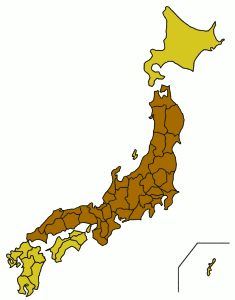Honshū
| Native name: 本州 | |
|---|---|

Honshu
|
|
| Geography | |
| Location | East Asia |
| Archipelago | Japanese archipelago |
| Area | 227,962.59 km2 (88,016.85 sq mi) |
| Area rank | 7th |
| Length | 1,300 km (810 mi) |
| Width | 50–230 km (31–143 mi) |
| Coastline | 5,450 km (3,386 mi) |
| Highest elevation | 3,776 m (12,388 ft) |
| Highest point | Mount Fuji |
| Administration | |
|
Japan
|
|
| Prefectures |
|
| Largest settlement |
|
| Demographics | |
| Population | 103,000,000 (2005 Census) |
| Pop. density | 447 /km2 (1,158 /sq mi) |
| Ethnic groups | Japanese |
Honshu ( Honshū?, "Main Island" or "Main Province") ([hoɴꜜɕɯᵝː]) is the largest and most populous island of Japan, located south of Hokkaido across the Tsugaru Strait, north of Shikoku across the Inland Sea, and northeast of Kyushu across the Kanmon Straits. The island separates the Sea of Japan, which lies to its north and west, from the North Pacific Ocean to its south and east. It is the seventh-largest island in the world, and the second-most populous after Java.
Honshu had a population of 103 million as of 2005[update], mostly concentrated in the coastal lowlands, notably in the Kantō plain where 25% of the total population resides in the Greater Tokyo Area. As the historical center of Japanese culture and political power, the island includes several past Japanese capitals, including Kyoto, Nara, and Kamakura. Much of the island's southern shore forms part of the Taiheiyō Belt, a megalopolis that spans several of the Japanese islands.
...
Wikipedia

